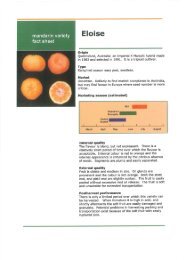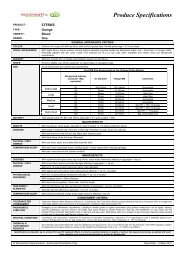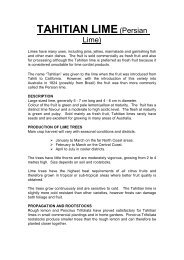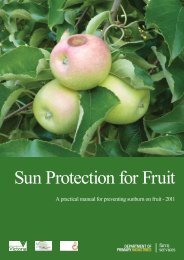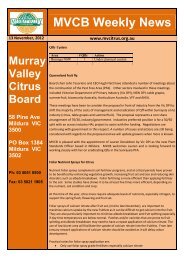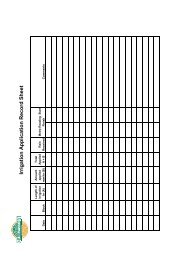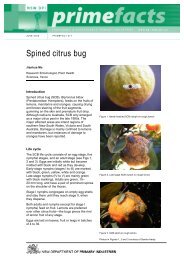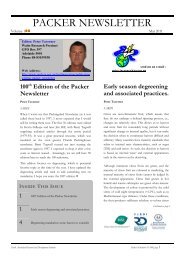Citrep #70 December 2012 - Murray Valley Citrus Board
Citrep #70 December 2012 - Murray Valley Citrus Board
Citrep #70 December 2012 - Murray Valley Citrus Board
Create successful ePaper yourself
Turn your PDF publications into a flip-book with our unique Google optimized e-Paper software.
12<br />
The first article described the Government’s<br />
National Carbon Offset Standard 2 , which<br />
sets out the definitions and rules that<br />
underpin how the national carbon<br />
sequestration market will operate. The<br />
second article in the series described the<br />
amounts of carbon in citrus trees, and<br />
how those amounts change over the first<br />
two decades or so of a planting’s life. That<br />
article also discussed the feasibility of<br />
citrus producers offering a sequestration<br />
service based on growing trees given the<br />
definitions and rules contained in the<br />
National Carbon Offset Standard. The third<br />
article discussed soil carbon; how much<br />
was there, and what the capacity was to<br />
increase those amounts in the top metre<br />
or so given the amounts found in other<br />
soils around the world.<br />
This article, the fourth and final in the<br />
series, draws together and summarises the<br />
important points that citrus producers, and<br />
the citrus industry, will need to understand<br />
and may wish to consider when participating<br />
in the debate about any national carbon<br />
sequestration market, as well as involvement<br />
in that market at some point in the future.<br />
CARBON SEQUESTRATION<br />
Part of the Government’s strategy to meet<br />
its GHG reduction targets is to offset the<br />
release of CO 2 by encouraging the removal<br />
of CO 2 from the atmosphere using biological<br />
and geological processes and preventing<br />
that carbon from being released back into<br />
the atmosphere. At first glance it seems<br />
logical that Australian agriculture could<br />
be a major player in the provision of<br />
sequestration services to those industries<br />
seeking to offset their GHG emissions.<br />
However, the Government’s National Carbon<br />
Offset Standard stipulates that any carbon<br />
sequestered must be additional to the<br />
amount that would have been sequestered<br />
in the normal course of events. Removing<br />
old citrus trees and replanting with young<br />
Newsletter of the <strong>Murray</strong> <strong>Valley</strong> <strong>Citrus</strong> <strong>Board</strong><br />
Carbon Trading and The <strong>Citrus</strong> Industry<br />
In earlier articles the attention of Australian citrus producers was drawn to the Federal<br />
Government’s Carbon Farming Initiative 1 , which forms part of its strategy to reduce Australia’s<br />
net emissions of greenhouse gases (GHG). The Initiative is based on the sequestration of carbon<br />
in either soil or plant material.<br />
trees would be viewed as “business as<br />
usual”, and therefore, the carbon that<br />
would be accumulated in the leaves,<br />
branches and trunk as the trees grew would<br />
not be viewed as offsetting GHG released<br />
elsewhere in the economy. In other words,<br />
under the Standard’s current definitions<br />
and rules, citrus producers would not be<br />
able to provide a carbon sequestration<br />
service based on just growing trees. There<br />
are other reasons why a carbon sequestration<br />
service based on growing citrus trees is an<br />
unattractive proposition, but the Standard’s<br />
“business as usual” stipulation is probably<br />
the main one.<br />
On the other hand, increasing the level of<br />
soil carbon in citrus orchards, and agricultural<br />
land more generally, does potentially qualify<br />
as an eligible sequestration service. It would<br />
need to be argued, and accepted by the<br />
agency charged with administering the<br />
sequestration market, that any additional<br />
carbon in the soil after the start of the<br />
service was due to a change in management/<br />
cultural practice. This would need to be<br />
based on solid knowledge of how much<br />
carbon was in the soil at the start, and<br />
therein lays a major issue. There are very<br />
few measurements of soil carbon available<br />
that could seriously be considered as<br />
baseline data for how much carbon<br />
is present in agricultural soils. Some<br />
industries may be slightly better off<br />
than others in this regard, but the citrus<br />
industry as a whole has very few data<br />
on organic carbon levels in soils used for<br />
citrus production. That deficiency can be<br />
overcome by collecting samples and taking<br />
measurements in a structured broad-based<br />
program that addresses the issue of natural<br />
variability in soil carbon levels across<br />
different growing regions/locations.<br />
Other technologies are currently being<br />
researched that might make this task<br />
much simpler and less costly 3 . However, it<br />
is not clear how far off these technologies<br />
are, and, in any case, there would need<br />
to be local verification/calibration work<br />
carried out before they could be accepted.<br />
Further, having solid baseline data will be<br />
critical to satisfying other rules set out in<br />
the Standard: namely, that the amount of<br />
carbon claimed to be sequestered must be<br />
measurable and verifiable.<br />
That issue aside, economies of scale also<br />
become important here because of some<br />
of the other features of the Standard.<br />
Firstly, carbon is to be sequestered for at<br />
least 100 years, and it will be difficult for<br />
any individual or entity to guarantee that<br />
a particular parcel of land will be managed<br />
for that period of time in such a manner<br />
as to not run down soil carbon levels. It<br />
is also very difficult for any individual or<br />
entity to provide an iron-clad guarantee<br />
that a specific “bundle” of carbon dioxide<br />
sequestered, will still be there in 100<br />
years time. It is also possible that having<br />
entered into a contract with another party<br />
to provide a sequestration service, that<br />
party may in fact have some claim on that<br />
parcel of land, which may affect its future<br />
use and value.<br />
Secondly, the Standard calls for<br />
measurements and auditing. Presumably<br />
these will be the responsibility of the<br />
sequestration service provider, and<br />
presumably may need to be carried out<br />
more than once over the 100 year period.<br />
The Standard also requires sequestration<br />
service providers to be registered. All of<br />
these involve cost, which may be on-going<br />
and, given the 100 year stipulation, way<br />
beyond the life of the person or entity that<br />
entered into the agreement in the first place.<br />
Some of these limitations may be overcome<br />
by individual producers or businesses acting<br />
collectively. Indeed, the Federal Government’s<br />
Carbon Farming Initiative allows for small<br />
providers of sequestration services to<br />
aggregate and collectively provide a large<br />
sequestration service.<br />
1 Design of the Carbon Farming Initiative. Consultation Paper. Department of Climate Change and Energy Efficiency. 2010.<br />
2 http://www.climatechange.gov.au/government/initiatives/~/media/publications/carbon-accounting/revised-NCOS-standard-pdf.ashx<br />
3 Knadel, M., Thomsen, A. and Greve, M. 2011. Multisensor on-the-go mapping of soil organic carbon content. Soil Science Society of America Journal 75, 1799-1806.




